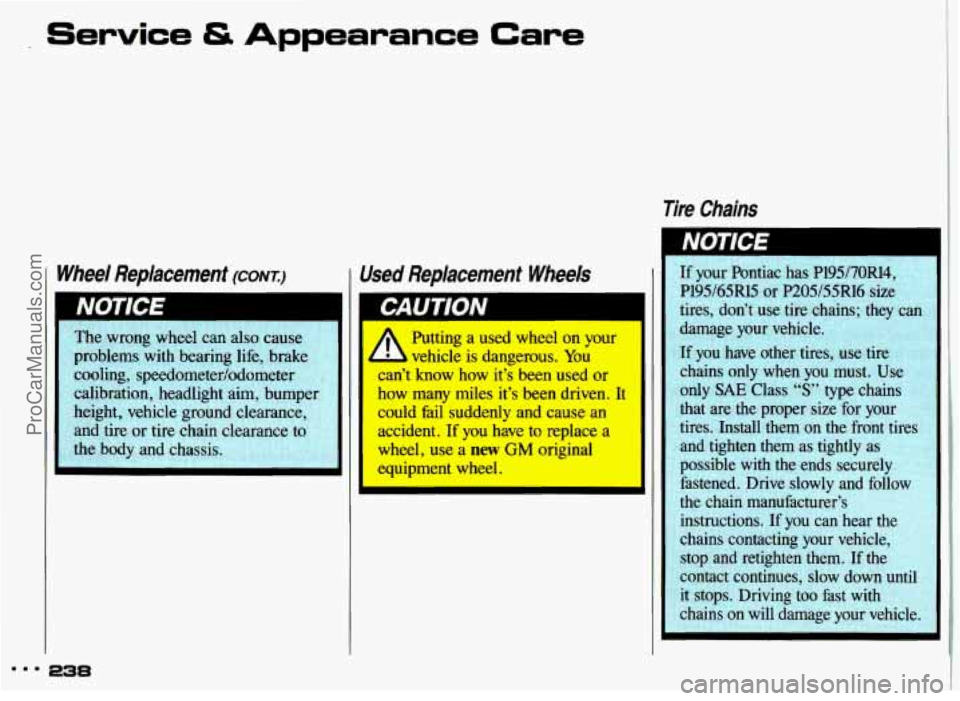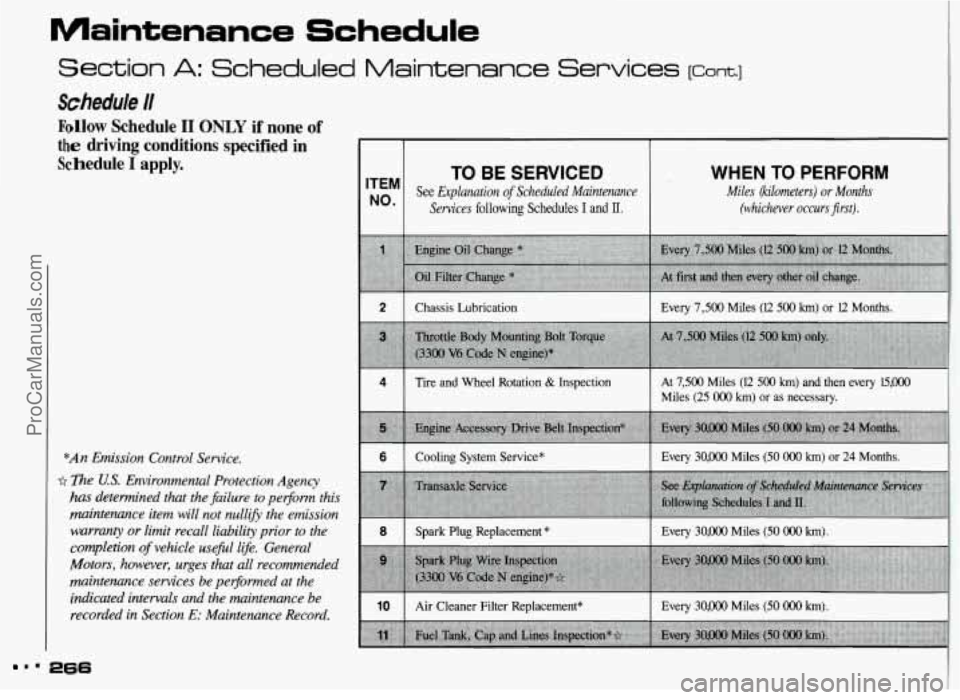Page 184 of 306
NOTICE
A
You can be burned if you spill
coolant on hot engine
parts.
Coolant contains ethylene glycol
and it will burn if the engine parts
are hot enough. Don’t spill coolant
on a hot engine.
1. You can remove the coolant surge
tank pressure cap when the cooling
system, including the coolant surge
tank pressure cap and upper radiator
hose, is no longer hot. Turn the
pressure cap slowly about
?A turn to
the left and then stop.
If you hear a hiss, wait for that to stop.
A hiss means there is still some pressure
left.
183 .
ProCarManuals.com
Page 222 of 306

Engine Coolant
The following explains your cooling system and how to add coolant when it
is low. If you have a problem with
engine overheating, see the
Index under
Engine Overheating.
The proper coolant for your Pontiac
will:
Give freezing protection down to
Give boiling protection up to 262°F
Protect against rust and corrosion.
Help keep the proper engine
-34°F (-37°C).
(128°C).
temperature.
Let the warning
should. lights work as they
What to Use:
Use
a mixture of one-half clean water
(preferably distilled) and one-half
antifreeze that meets
“GM Specification
1825-M,” which won’t damage
aluminum parts. You can
also use a
recycled coolant conforming to GM
Specification 1825-M with a complete
coolant flush and refill. If you use this
mixture, you don’t need to add anything
else.
CAUTION I
A Adding only plain water ta
L pur cooling system can be
dangerous. Plain water, or some
other liquid like alcohol, can boil
bebe the proper coolant mix will.
system is set for the proper coolant
mix. With plain water or the
wrong mix, your engine could get
too hot but you wouldn’t get the
overheat warning, Your engine
could catch fire and you or others
could be burned. Use a 50/50 mix
of clean water and a proper
antifreeze.
Your v&hicle’s coolant warning
221 .
ProCarManuals.com
Page 239 of 306

Service & Appearance Care
Tire Chains
...
Wheel Replacement (CONT.)
The wrong wheel can also cause
problems with bearing life, brake cooling, speedometer/odometer
calibration, headlight aim, bumper
height, vehicle ground clearance,
and tire or tire chain clearance to
the body and chassis.
I
238
Used Replacement Wheels
Putting a used wheel on your
L vehicle is dangerous. You
I cs know how it’s been used or
how many miles it’s been driven. It
-mid fail suddenly and cause an
accident. If you have
to replace a
\wheel, use a
new GM original If your Pontiac has P195/70R14,
P195/65R15
or P205/55R16 size
tires, don’t use tire chains; they can
damage your vehicle.
If you have other tires, use tire
chains only when you must. Use
only
SAE Class “S” type chains
that are
the proper size for your
tires. Install them
on the front tires
and tighten them as tightly as
possible with the ends securely fastened. Drive slowlv and follow
r’
the chain manufacturer’s
instructions. If you can
h
chains contacting your v
stop and retighten them. If the
contact continues, slow down until
it stops. Driving too fast with
chains on will damage your vehicle.
ProCarManuals.com
Page 252 of 306
Capacities & Specifications
Engine Crankcase (All Models) .......................... 4 quarts
Automatic Transaxle
Men changing Jilter, up to I quart (I liter) more oil may be needed.
Pan Removal and Replacement .......................... 4 quarts
After Complete Overhaul
.............................. 6 quarts
When draining or replacing torque converter, more fluid may be needed.
Manual Transaxle, 5-Speed
Complete Drain and Refdl
T5550 ........................................... 2.1quarts
Isuzu
............................................. 2.0 quarts
2.3L Quad OHC and Quad 4 ........................... 10.4 quarts
3300V6 ........................................... 10.8quarts
Cooling System
3.8 L
3.8 L
5.5 L
2.0 L
1.9 L
9.8 L
10.2 L
I
251
ProCarManuals.com
Page 267 of 306

Maintenance Schedule
Section A: Scheduled Maintenance Services lcont.1
Schedule I1
Follow Schedule I1 ONLY if none of
the driving conditions specified in
Schedule
I apply.
*An Emission Control Sewice.
fi The US. Environmental Protection Agency
has determined that the failure to per$orm this
maintenance item
will not nullifL the emission
warranty or limit recall liability prior to the
completion
of vehicle usefil life. General
Motors, however, urges that
all recommended
maintenance services be per$ormed at the
indicated intervals and the maintenance be recorded in Section
E: Maintenance Record.
TO BE SERVICED
See &planation of Scheduled Maintenance
Services following Schedules I and II.
ITEM
No'
WHEN TO PERFORM
Miles (kilometers) or Months
(whichever occurs first).
2 I Chassis Lubrication 1 Every 7,500 Miles (E 500 km) or 12 Months.
Tire and Wheel Rotation
& Inspection At 7,500 Miles (12 500 km) and then every l5,000
Miles (25 000 km) or as necessary.
6 I Cooling System Service* I Every 30,000 Miles (50 000 km) or 24 Months.
8 I Spark Plug Replacement * I Every 30,000 Miles (50 000 km).
10 I Air Cleaner Filter Replacement* I Every 30,000 Miles (50 000 lan).
' 266
ProCarManuals.com
Page 270 of 306

ITEM
NO. SERVICE
5 Engine Accessory Drive Belt Inspection*-
Inspect the belt. for cracks, fraying, wear and
proper tension. Replace
as needed.
6 Cooling System Service*-Drain, flush and refill
the system with new or approved recycled coolant
conforming to
GM Specification 1825M. Keep
coolant at the proper mixture as specified. See the
Index under Coolant. This provides proper freeze
protection, corrosion inhibitor level and engine
operating temperature.
Inspect hoses and replace if they are cracked,
swollen or deteriorated. Clean the outside of the
surge
tank and air conditioning condenser.
To help ensure proper operation, we recommend a
pressure test
of both the cooling system and the
surge
tank pressure cap.
doesn’t require changing.
7 Transaxle Service-For a manual transaxle, fluid
ITEM
NO. SERVICE
For an automatic transaxle, change both the fluid
and filter every
15,000 miles (25 OOO krn) if the
vehicle is mainly driven under one or more
of these
conditions:
In heavy city traffic where the outside temperature
regularly reaches 90°F
(32OC) or higher.
In hilly or mountainous terrain.
When doing frequent trailer towing. With some
models, you shouldn’t even tow a trailer. See the
Index under Towing a Trailer.
Uses such as found in taxi, police car or delivery
service.
8
9
If you do not use your vehicle under any of
these conditions, change both the fluid and filter
every 100,000 miles
(160 000 km).
Spark Plug Replacement *-Replace spark plugs
with the proper type. See the
Index under
Replacement Parts.
Spark Plug Wire Inspection (3300 V6 Code N
engine)**-Inspect for burns, cracks or other
damage. Check the boot fit at the coils and at the
spark plugs, Replace wires as needed.
ProCarManuals.com